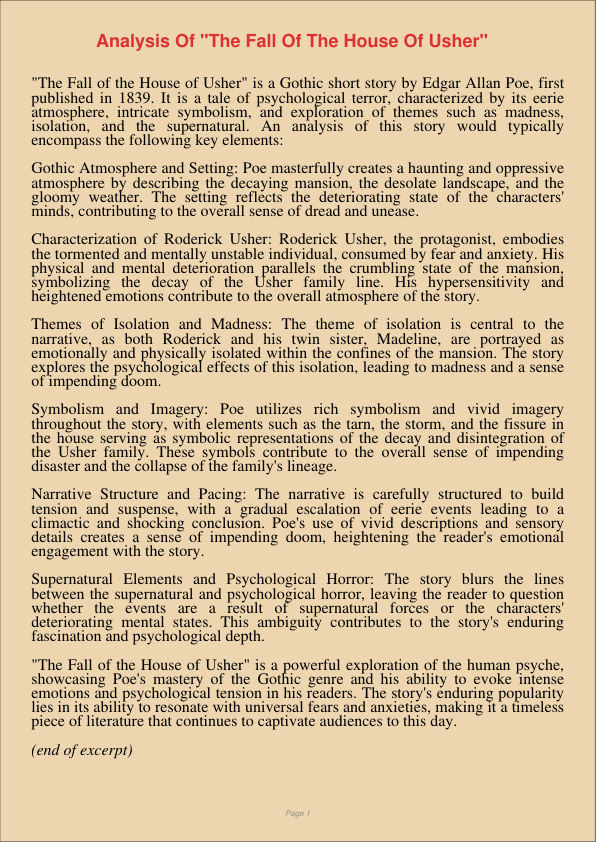Analysis Of The Fall Of The House Of Usher
Dec 31, 2023
usher
house
Nursing
Sociology

“The Fall of the House of Usher” is a Gothic short story by Edgar Allan Poe, first published in 1839. It is a tale of psychological terror, characterized by its eerie atmosphere, intricate symbolism, and exploration of themes such as madness, isolation, and the supernatural. An analysis of this story would typically encompass the following key elements:
Gothic Atmosphere and Setting: Poe masterfully creates a haunting and oppressive atmosphere by describing the decaying mansion, the desolate landscape, and the gloomy weather. The setting reflects the deteriorating state of the characters’ minds, contributing to the overall sense of dread and unease.
Characterization of Roderick Usher: Roderick Usher, the protagonist, embodies the tormented and mentally unstable individual, consumed by fear and anxiety. His physical and mental deterioration parallels the crumbling state of the mansion, symbolizing the decay of the Usher family line. His hypersensitivity and heightened emotions contribute to the overall atmosphere of the story.
Themes of Isolation and Madness: The theme of isolation is central to the narrative, as both Roderick and his twin sister, Madeline, are portrayed as emotionally and physically isolated within the confines of the mansion. The story explores the psychological effects of this isolation, leading to madness and a sense of impending doom.
Symbolism and Imagery: Poe utilizes rich symbolism and vivid imagery throughout the story, with elements such as the tarn, the storm, and the fissure in the house serving as symbolic representations of the decay and disintegration of the Usher family. These symbols contribute to the overall sense of impending disaster and the collapse of the family’s lineage.
Narrative Structure and Pacing: The narrative is carefully structured to build tension and suspense, with a gradual escalation of eerie events leading to a climactic and shocking conclusion. Poe’s use of vivid descriptions and sensory details creates a sense of impending doom, heightening the reader’s emotional engagement with the story.
Supernatural Elements and Psychological Horror: The story blurs the lines between the supernatural and psychological horror, leaving the reader to question whether the events are a result of supernatural forces or the characters’ deteriorating mental states. This ambiguity contributes to the story’s enduring fascination and psychological depth.
“The Fall of the House of Usher” is a powerful exploration of the human psyche, showcasing Poe’s mastery of the Gothic genre and his ability to evoke intense emotions and psychological tension in his readers. The story’s enduring popularity lies in its ability to resonate with universal fears and anxieties, making it a timeless piece of literature that continues to captivate audiences to this day.